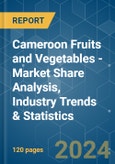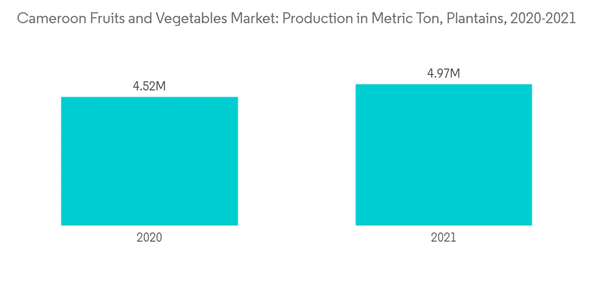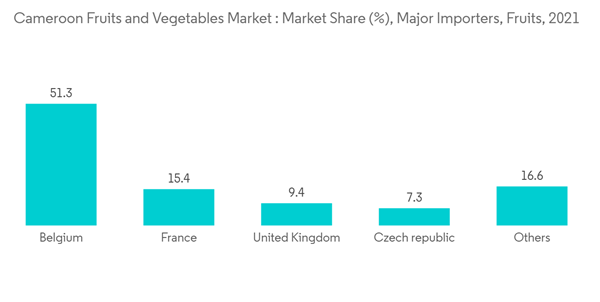The Cameroon Fruits and Vegetables Market size is estimated at USD 2.48 billion in 2024, and is expected to reach USD 3.38 billion by 2029, growing at a CAGR of 6.42% during the forecast period (2024-2029).
The increasing consumer demand is forcing producers to expand the production area. For instance, the banana harvesting area increased from 19,410 ha in 2020 to 21,800 ha in 2021. Improving farming techniques through increased investment by public and private companies in the market contributes to the expansion of the market. Developed varieties of plantains and bananas are anticipated to boost the production rate in the country. For instance, Green-House Ventures, specializing in modern agricultural techniques, aims to bridge the gap by massively cultivating nutritious fruits. Thus, the rising demand for fruits, government support, and the adoption of modern farming techniques may positively impact the market's growth. Thus, considering these factors, the market is projected to record a healthy growth rate over the forecast period.
Cameroon's fruit trade has not only seen an increase in volumes and value, but the variety of fruits being traded has also grown, creating more opportunities. Among fruits, banana is the major fruit exported, followed by dates, figs, and pineapples. Improvement in cultivation techniques in banana cultivation helps increase the production of bananas, thereby driving export growth.
According to ITC Trademap, the major export destinations for Cameroonian fruits are Belgium and France, which held a share of 51.3% and 15.4%, respectively, in 2021. Therefore, growing export opportunities due to the increasing demand and a rising trend of a healthy diet are boosting Cameroon's fruits and vegetables market.
This product will be delivered within 2 business days.
Key Highlights
- Cameroon farmers produce a wide range of fruits, including bananas, avocados, dates, figs, mangoes, guavas, papayas, watermelon, etc., and vegetables, such as cabbages, cassava, chilies, peppers, cucumbers, gherkins, eggplants, okra, plantains, onions, and tomatoes.
- The growing health consciousness among the country's population, changing lifestyles and preferences, rising disposable incomes, and growing awareness regarding the health benefits associated with fruits, including bananas, mangoes, dates, etc., are driving the market's growth. The rising domestic demand increased the production of fruits in 2021 by 7.1% to 6.7 million metric ton from the previous year. The harsh and extremely cold climatic conditions may prevent production, restraining the market's growth.
- According to the FAO, total vegetable production accounted for 2.8 million metric ton in 2021. Cassava was the most produced crop in Cameroon, with a production of 4.9 million metric ton in 2021, followed by plantains, with 4.8 million metric ton. The increasing production of fruits and vegetables due to improvements in production techniques is driving exports, which may boost the market during the forecast period.
Cameroon Fruits and Vegetable Market Trends
Plantains and Bananas Dominated the Fruit Segment
According to the FAO, plantains and bananas are the most cultivated fruit crops in Cameroon, with the production of 4.9 million metric ton and 4.8 million metric ton, respectively, in 2021 and 2020, followed by pineapples, avocados, and watermelons.The increasing consumer demand is forcing producers to expand the production area. For instance, the banana harvesting area increased from 19,410 ha in 2020 to 21,800 ha in 2021. Improving farming techniques through increased investment by public and private companies in the market contributes to the expansion of the market. Developed varieties of plantains and bananas are anticipated to boost the production rate in the country. For instance, Green-House Ventures, specializing in modern agricultural techniques, aims to bridge the gap by massively cultivating nutritious fruits. Thus, the rising demand for fruits, government support, and the adoption of modern farming techniques may positively impact the market's growth. Thus, considering these factors, the market is projected to record a healthy growth rate over the forecast period.
Growing Export Opportunities
According to the FAOSTAT, the export of fruits accounted for USD 290,661 thousand in 2021, an increase of 1.5% from the previous year. The increasing demand for fruits from the United Kingdom mostly drives the increase in export value. For instance, Cameroon's fruit export to the United Kingdom increased by 22.3% in 2021.Cameroon's fruit trade has not only seen an increase in volumes and value, but the variety of fruits being traded has also grown, creating more opportunities. Among fruits, banana is the major fruit exported, followed by dates, figs, and pineapples. Improvement in cultivation techniques in banana cultivation helps increase the production of bananas, thereby driving export growth.
According to ITC Trademap, the major export destinations for Cameroonian fruits are Belgium and France, which held a share of 51.3% and 15.4%, respectively, in 2021. Therefore, growing export opportunities due to the increasing demand and a rising trend of a healthy diet are boosting Cameroon's fruits and vegetables market.
Cameroon Fruits and Vegetable Industry Overview
Additional Benefits:
- The market estimate (ME) sheet in Excel format
- 3 months of analyst support
This product will be delivered within 2 business days.
Table of Contents
1 INTRODUCTION
4 MARKET DYNAMICS
5 MARKET SEGMENTATION
6 INTERNATIONAL TRADE AND PRICE SCENARIOS
7 REGIONAL ANALYSIS
8 COMPETITIVE ANALYSIS
Methodology

LOADING...










